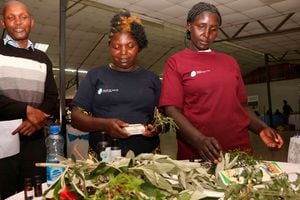
National Drought Management Authority (NDMA) CEO Hared Adan during the National Steering Committee on Drought Response (NSCDR) drought response update media briefing at the Nairobi Serena on December 20, 2022.
The National Drought Management Authority has warned Kenyans that should disaster strike, they will be on their own as the agency's coffers have run dry.
The authority's CEO Hared Adan told a parliamentary committee that they used to have Sh2 billion for drought emergencies but in the current financial year, they have been allocated only Sh20 million for all their operations.
The authority decried to MPs that despite helping even during other disasters such as floods, invasion of locusts and hunger-affected areas, they now have no resources to intervene in case of such emergencies.
“Due to its presence at the county level, the authority is frequently called upon to support data collection and coordination of other hazards such as floods, locust invasions, resources-based conflicts, livestock and human disease outbreaks, putting pressure on meager resources,” Mr Adan said.
Also Read: How Africa can navigate climate crisis
Mr Adan told the National Assembly Regional and Development Committee that had it not been for the support from donor partners, they could not be operating now.
He told MPs that the authority requires Sh60 million to coordinate the bi-annual multi-sectoral, multi-agency food security assessment but has only mobilised only Sh30 million from various stakeholders but zero budget from the government.
The food security assessment plays a critical role in informing the government decision making such mobilisation of resources for emergencies.
The authority also has no budget from the government for drought coordination despite being its core function. The CEO said they require Sh90 million annually for this function.
So dire is the situation that Mr Adan told MPs that they rely on donor funds to pay the mandatory statutory deductions for their employees.
“If today, we don’t have our partners, we won’t even be able to pay our statutory deductions,” Mr Adan said.
“We will require the help of this committee and we will be coming before you for a supplementary budget."
Due to the financial challenges, Mr Adan said the authority's plan to open one satellite office to serve Kiambu, Nakuru and Murang’a has been halted.
He said they need Sh10 million to serve people who are suffering in the three counties.
Further, Mr Adan said that 20 of their projects, which are partially financed by donors have also stalled since part of the financing from the government has not been forthcoming.
“We cannot undertake these projects because part of the financing from the government is not forthcoming,” Mr Adan told MPs.
The authority is a statutory body established under the National Management Authority Act, 2016 to exercise overall coordination over all matters relating to drought risk management.
The authority is also mandated to establish mechanisms either on its motion or with stakeholders that are aimed at ending drought emergencies in the country.
Despite having a national mandate, the authority currently operates in 23 Arid and Semi-arid lands counties.
The authority coordinates its drought-related function through the National Drought Emergency Fund (NDEF) Act, 2012 which was operationalised through the Public Finance Management (National Drought Emergency Fund) Regulations, 2021 as a complimentary financing mechanism.
The Fund's purpose is to facilitate resilience building, preparedness and timely response to drought during its different stages to reduce its negative effects.
Since its establishment in 2021, the fund has received Sh483 million which includes Sh200 million in the 2021/2022 financial year, Sh263 million in the 2022/2023 financial year and Sh20 million in the 2023/2024 financial year.










